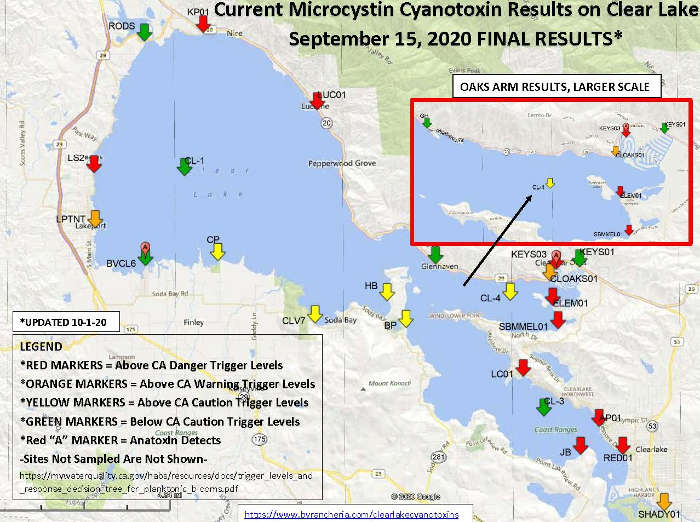
LAKE COUNTY, Calif. – Newly reported sampling data from numerous sites around Clear Lake have revealed high levels of cyanotoxin.
Public Health Officer Dr. Gary Pace reported that sampling conducted on Sept. 15 detected concerning levels of cyanotoxin at 19 Clear Lake sites, which can be seen on the map above, a larger version of which can be found here.
Big Valley Band of Pomo Indians and Elem Indian Colony conduct regular monitoring on sites across Clear Lake.
On its cyanotoxin monitoring website, Big Valley reported that on Sept. 15 they collected water samples from 24 sites on and in the lake. Cyanobacteria blooms were in most of those locations, so the tribe said it further reviewed those samples to get preliminary toxin data.
Sites showing testing results above the caution and warning trigger levels are:
– Four areas Lakeport: First Street boat ramp, Big Valley Shoreline, Lakeside County Park and a site in the Upper Arm of the lake;
– Three areas near Kelseyville: Soda Bay Cove, Horseshoe Bend and Buckingham Park;
– Two areas in Clearlake Oaks:the Oaks Arm of the lake and the west side of the Clearlake Keys; and
– One site in Clearlake: Shady Acres on Cache Creek.
Sites with results in the danger level are on Lakeshore Drive, north of Lakeport; Lucerne Harbor Park; Keeling Park in Nice; the Elem Colony and the Sulphur Bank mercury mine Superfund site, both in Clearlake Oaks; Lily Cove, Austin Park Beach and Redbud Park in Clearlake; and Jago Bay in Lower Lake.
Pace said people and pets should stay out of the water in those areas. Don’t touch scum in the water or on the shore. Don’t let pets drink the water. Fish and shellfish from those areas should not be eaten.
Symptoms of exposure include skin rashes, eye irritation, diarrhea and vomiting. Pets who contact the toxin can experience seizures and death. Pace said to contact a medical provider or veterinarian if symptoms due to exposure are suspected.
Much of the aquatic plant growth visible in Clear Lake is harmless, and there is no need to be overly concerned about activities in areas of the lake where algae blooms are not present, Pace said.
Centers for Disease Control and Prevention guidance regarding harmful algal blooms can be found here.
“This is a challenging time with the fires, poor air quality, and COVID, but harmful algal blooms can cause significant suffering, so we encourage people to be careful and be aware of the risks,” Pace said.

 How to resolve AdBlock issue?
How to resolve AdBlock issue? 



